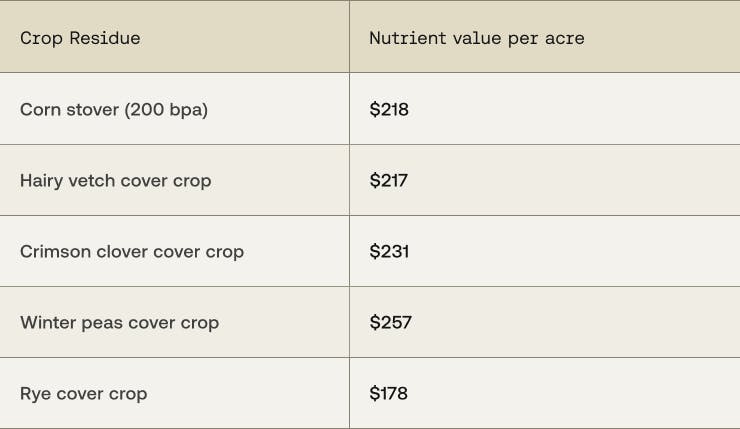
The benefits of reduced tillage are clear. Less fuel, less labor, better soil structure. But one challenge remains: residue.
Many farmers turn to nitrogen to manage it. Extra N speeds decomposition and helps maintain yields when heavy stalks slow things down. The problem is, that nitrogen doesn’t always stay where you want it. Runoff carries it away, raising both environmental concerns and fertilizer bills. Over time, those costs can erode the financial gains of reduced tillage.
Re-Gen was built for this situation. By accelerating residue breakdown and releasing nutrients already tied up in stalks and stems, it reduces the need to lean so heavily on added nitrogen.
The economics of nitrogen under reduced tillage
Residue protects soil but ties up nutrients as it decomposes. When microbes consume the carbon in stalks and stems, they pull nitrogen out of the soil to fuel the process. Crops can be left short during critical growth windows.
The common solution is simple: apply more N. But this “insurance” carries hidden costs:
- Higher fertilizer bills. Nationally, nitrogen prices have fluctuated between $0.40 and $1.00 per unit over the past decade. On a 200-acre corn farm, an extra 40 units/acre can add $3,200–$8,000 to annual costs.
- Losses to runoff or leaching. Studies suggest 20–40% of applied nitrogen may never be used by the crop. That’s money spent with no return.
- Reducing ROI. Reduced tillage saves fuel (often $20–$40/acre) and labor, but when nitrogen use climbs to compensate for residue, those savings can vanish.
In other words: nitrogen can keep yields steady, but it can also cancel out the financial case for conservation tillage.
The hidden value in residue
Crop residues contain significant nutrient and biological value—value that can be captured instead of replaced with synthetic fertilizer.
When residue is left to decompose slowly, much of that value remains locked up through the growing season. The farmer still pays for added nitrogen to fill the gap. But when residue decomposition is accelerated, those nutrients cycle back sooner and offset the need for added fertilizer.
In other words, every pound of nitrogen you don’t have to apply is not just a stewardship win. It’s a direct savings.

Why biology changes the math
Residue breaks down because of biology, not tillage. Fungi begin the process by tackling lignin and cellulose, while bacteria follow with faster nutrient release. In reduced-till systems, fungi should dominate, creating steady, long-term nutrient cycling. But when residue overwhelms the system, growers often resort to nitrogen to keep things moving.
That short-circuits the biology. Large early N applications fuel bacteria, leading to a quick flush of nutrients that may not align with crop demand. The crop still needs sidedress, and some of the early nitrogen is lost. The result is more money spent with less efficiency.
Supporting the biology directly—rather than forcing it with nitrogen—keeps the natural succession on track. That means nutrients come off residue in a steadier, more predictable way that aligns with crop uptake.
Where Re-Gen fits
Re-Gen is ideal for residue-rich, reduced-till systems. Applied directly to stalks and stems, its blend of fungi and bacteria complements the natural decomposition process. Because the microbes are freeze-dried and reanimated on-farm, they can be applied at densities far higher than typical biologicals—on the order of 100,000X more organisms per acre.
In university trials, Re-Gen has:
- Recaptured up to $218 per acre of NPK from corn residue
- Increased corn yields by about 20 bushels per acre
- Improved milk yield in silage systems by nearly 4%
On average, these results translated to a 5X return on investment. Just as importantly, they reduced reliance on added nitrogen by making residue part of the fertility program instead of an obstacle.
Practical economics for reduced-till farms
- Account for real costs. Fuel and labor savings from reduced tillage can total $25–$40 per acre. But if managing residue requires an extra $20–$30 in nitrogen, much of that advantage is lost.
- Factor in loss. Research shows 30–50 percent of applied N can be lost to leaching, runoff, or volatilization. At $0.75 per pound, losing 30 pounds per acre is over $20 gone with no return.
- Value your residue. Corn stover can hold $200 or more in nutrients per acre. With the right biology, those nutrients offset purchased fertilizer. Without it, they remain tied up while you pay again for replacements.
- Track your returns. Side-by-side strips show whether accelerated residue breakdown lets you cut early N rates without sacrificing yield. Even a 10% reduction in applied nitrogen can drive significant ROI.
The bottom line
Farmers who have already reduced tillage are on the path to healthier soils. But many are offsetting residue challenges with higher nitrogen rates, raising both costs and runoff risks. Added nitrogen may solve a short-term problem, but it eats into the long-term financial case for reduced tillage.
Re-Gen offers a different approach. By unlocking the nutrient value of residue, it reduces dependence on added N, improves planting conditions, and makes reduced-till systems more profitable.
It is not a stand-alone solution. Cover crops, nutrient management, and reduced disturbance remain essential. But for farmers caught in the nitrogen tradeoff, Re-Gen can help tip the balance—turning residue from a cost driver into a source of return.





